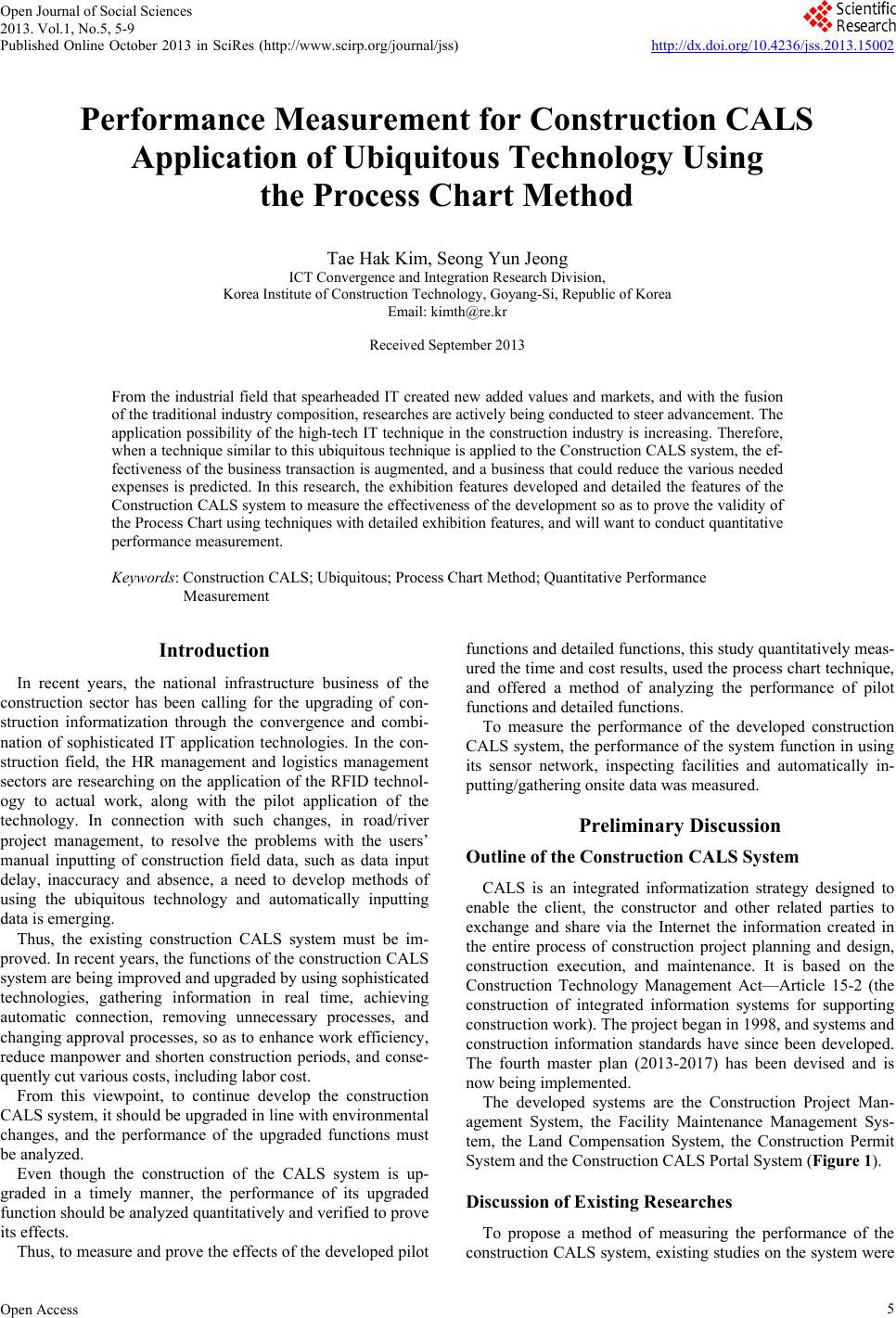
Open Journal of Social Sciences
2013. Vol.1, No.5, 5-9
Published Online October 2013 in SciRes (http://www.scirp.org/journal/jss) http://dx.doi.org/10.4236/jss.2013.15002
Open Access 5
Performance Measurement for Construction CALS
Application of Ubiquitous Technology Using
the Process Chart Method
Tae Hak Kim, Seong Yun Jeong
ICT Convergence and Integration Research Division,
Korea Institute of Construction Technology, Goyang-Si, Republic of Korea
Email: kimth@re.kr
Received September 2013
From the industrial field that spearheaded IT created new added values and markets, and with the fusion
of the traditional industry composition, researches are actively being conducted to steer advancement. The
application possibility of the high-tech IT technique in the construction industry is increasing. Therefore,
when a technique similar to this ubiquitous technique is applied to the Construction CALS system, the ef-
fectiveness of the business transaction is augmented, and a business that could reduce the various needed
expenses is predicted. In this research, the exhibition features developed and detailed the features of the
Construction CALS system to measure the effectiveness of the development so as to prove the validity of
the Process Chart using techniques with detailed exhibition features, and will want to conduct quantitative
performance measurement.
Keywords: Construction CALS; Ubiquitous; Process Chart Method; Quantitative Performance
Measurement
Introduction
In recent years, the national infrastructure business of the
construction sector has been calling for the upgrading of con-
struction informatization through the convergence and combi-
nation of sophisticated IT application technologies. In the con-
struction field, the HR management and logistics management
sectors are researching on the application of the RFID technol-
ogy to actual work, along with the pilot application of the
technology. In connection with such changes, in road/river
project management, to resolve the problems with the users’
manual inputting of construction field data, such as data input
delay, inaccuracy and absence, a need to develop methods of
using the ubiquitous technology and automatically inputting
data is emerging.
Thus, the existing construction CALS system must be im-
proved. In recent years, the functions of the construction CALS
system are being improved and upgraded by using sophisticated
technologies, gathering information in real time, achieving
automatic connection, removing unnecessary processes, and
changing approval processes, so as to enhance work efficiency,
reduce manpower and shorten construction periods, and conse-
quently cut various costs, including labor cost.
From this viewpoint, to continue develop the construction
CALS system, it should be upgraded in line with environmental
changes, and the performance of the upgraded functions must
be analyzed.
Even though the construction of the CALS system is up-
graded in a timely manner, the performance of its upgraded
function should be analyzed quantitatively and verified to prove
its effects.
Thus, to measure and prove the effects of the developed pilot
functions and detailed functions, this study quantitatively meas-
ured the time and cost results, used the process chart technique,
and offered a method of analyzing the performance of pilot
functions and detailed functions.
To measure the performance of the developed construction
CALS system, the performance of the system function in using
its sensor network, inspecting facilities and automatically in-
putting/gathering onsite data was measured.
Preliminary Discussion
Outline of the Constr uc tion CALS System
CALS is an integrated informatization strategy designed to
enable the client, the constructor and other related parties to
exchange and share via the Internet the information created in
the entire process of construction project planning and design,
construction execution, and maintenance. It is based on the
Construction Technology Management Act—Article 15-2 (the
construction of integrated information systems for supporting
construction work). The project began in 1998, and systems and
construction information standards have since been developed.
The fourth master plan (2013-2017) has been devised and is
now being implemented.
The developed systems are the Construction Project Man-
agement System, the Facility Maintenance Management Sys-
tem, the Land Compensation System, the Construction Permit
System and the Construction CALS Portal System (Figure 1).
Discussion of Existing Researches
To propose a method of measuring the performance of the
construction CALS system, existing studies on the system were